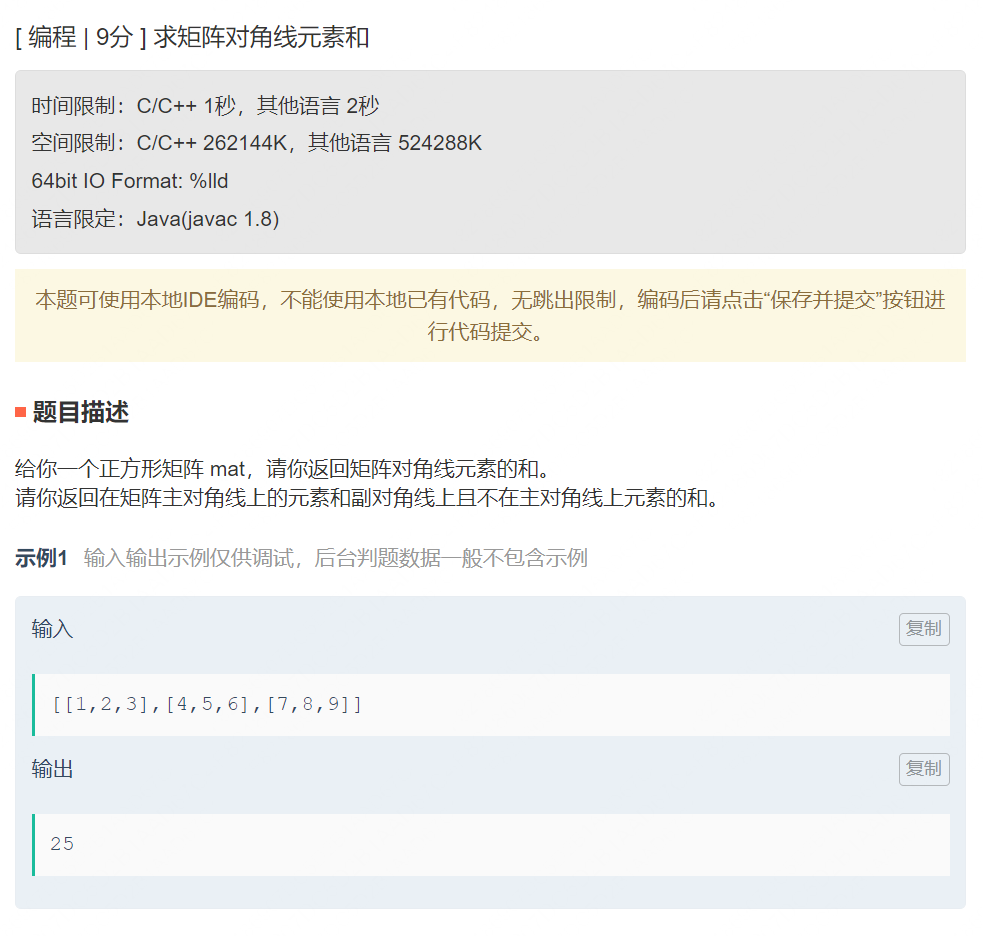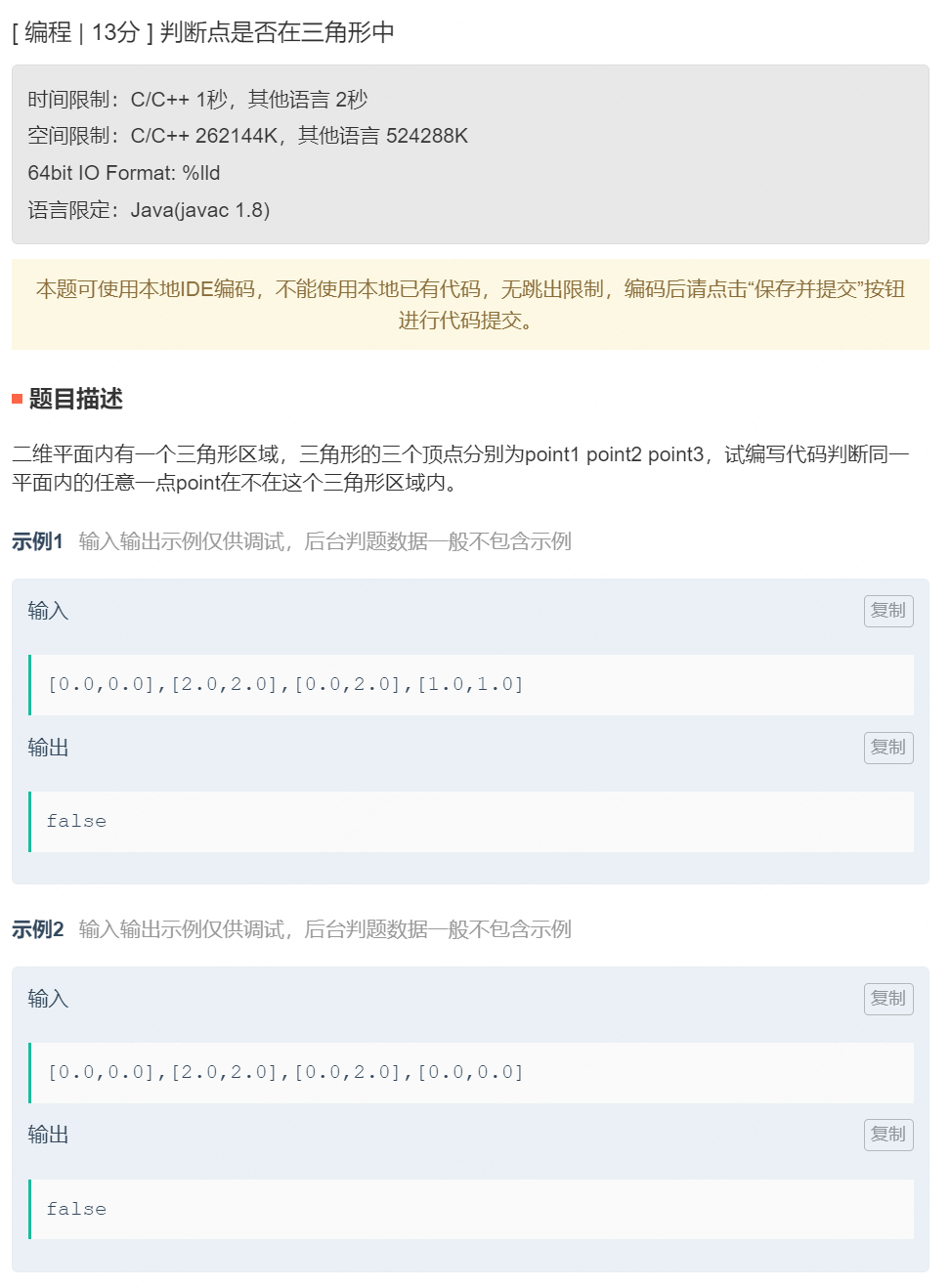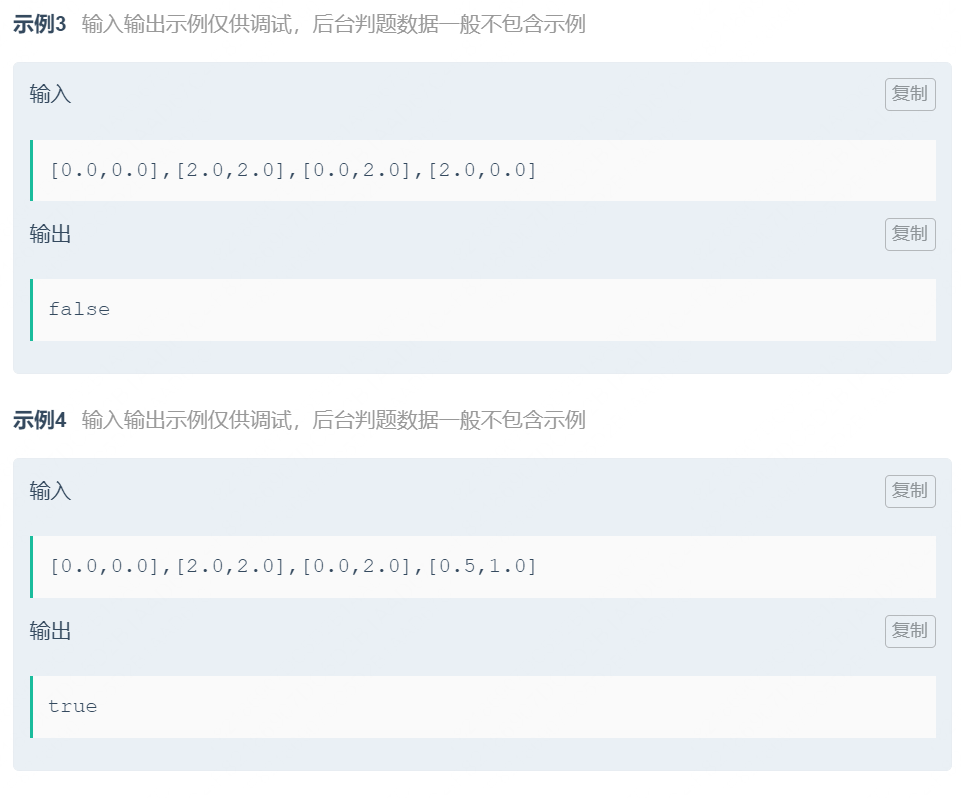中望龙腾的笔试题,做出来两道,另外一道实在是不会了
选择多选题
- java类相关知识
- static块
- 抽象类和接口
- 面向对象特点
- 多线程ThreadLocal
- JVM常量池
- IP字段计算
唉,这些东西,背了又忘,忘了又背,背了还忘
编程题
编程题1

题解
- 直接遍历获取主对角线和副对角线元素的和
- 然后如果矩阵为奇数方阵,需要减去重复的元素
1
2
3
4
5
6
7
8
9
10
11
12
13
14
15
16
17
18
19
20
| public class Solution {
public int diagonalSum (int[][] mat) {
int res = 0;
int n = mat.length;
for (int i = 0; i < n; i++) {
res += mat[i][i] + mat[n-1-i][i];
}
if (n % 2 != 0)
res -= mat[n/2][n/2];
return res;
}
}
|

编程题2


题解
这道题其实还挺常见的,特别是在游戏相关的岗位面试,结果我这菜鸡还是第一次遇到,直接蒙了…
现在下来想的话,有以下几种方法判断点是否在三角形内部:
- 三角形内角和为360度,也就是点和三角形任意两边组成一个角,这三个角的和为360度,但是浮点数计算存在误差,无法严格等于360度,该方法舍弃
- 三角形面积和,同样也是上一种方法,三角形内的点和三个顶点分别做直线,连接划分三个三角形,这三个三角形的面积和同原三角形面积相等,同样也存在浮点数计算误差的问题
- 第三种方法就是叉乘法,这一种方法比较适用,不会因为浮点数计算误差出现结果混淆的情况

如上图所示,三角形的各个边的向量方向是逆时针方向,计算边和三角形内点o的叉乘,例如
$$
\overrightarrow{CO} \times \overrightarrow{CA}
$$
如果点在三角形内部,按照叉乘的计算方式,上式的结果为正数,这就是叉乘判断的原理
但是在题目中,可能存在给的三角形顶点的顺序不是逆时针的顺序,所以需要进行判断

同样的也是判断叉乘公式
$$
\overrightarrow{p_1 p_2} \times \overrightarrow{p_1 p_3}
$$
如果为正数,则说明为逆时针方向,否则,调换 $p2, p3$ 的顺序
1
2
3
4
5
6
7
8
9
10
11
| double product(double p1,double p2,double p3) {
return (p2[0]-p1[0])*(p3[1]-p1[0]) - (p2[1]-p1[1])*(p3[0]-p1[0]);
}
bool isInTriangle(double p1,double p2, double p3, double o) {
if(product(p1, p2, p3)<0) return isInTriangle(p1,p3,p2,o);
if(product(p1, p2, o)>0 && product(p2, p3, o)>0 && product(p3, p1, o)>0)
return true;
return false;
}
|

编程题3

题解
这道题和 1091.二进制矩阵中的最短路径 不能说不像,只能说是一摸一样,唉,做了的题没做出来,太菜了
1
2
3
4
5
6
7
8
9
10
11
12
13
14
15
16
17
18
19
20
21
22
23
24
25
26
27
28
29
| class Solution {
public int shortestPathBinaryMatrix(int[][] grid) {
int[][] dirs = new int[][]{{-1, -1}, {-1, 0}, {-1, 1}, {0, -1}, {0, 1}, {1, -1}, {1, 0}, {1, 1}};
int n = grid.length, m = grid[0].length;
if (grid[0][0] == 1 || grid[n-1][m-1] == 1)
return -1;
boolean[][] visited = new boolean[n][m];
Queue<int[]> queue = new LinkedList<int[]>();
int[] start = new int[]{0, 0, 1};
queue.add(start);
while(!queue.isEmpty()) {
int[] temp = queue.poll();
for (int[] dir : dirs) {
int x = temp[0] + dir[0];
int y = temp[1] + dir[1];
int weight = temp[2];
if (temp[0] == n-1 && temp[1] == m-1)
return weight;
if (x >= 0 && x < n && y >=0 && y < m && grid[x][y] == 0 && !visited[x][y]) {
queue.add(new int[]{x, y, temp[2] + 1});
visited[x][y] = true;
}
}
}
return -1;
}
}
|







